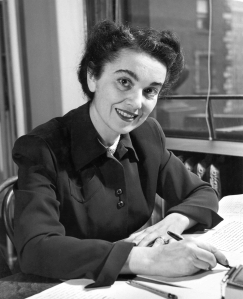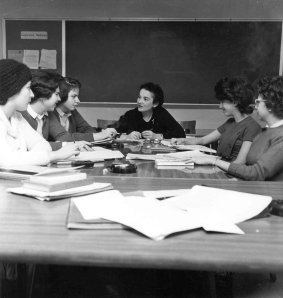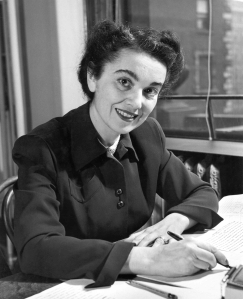Born into a privileged family in Tsarist Russia, Mirra Komarovsky’s (2/5/1905 – 1/30/1999) life took a sharp turn when the 1917 Russian Revolution forced her family to immigrate to the United States. Shortly after arriving in the country, she enrolled at Barnard and immersed herself in studying the social sciences. She later became a nationally recognized sociologist, specializing in the sociology of gender, and was a Barnard professor from 1937 to 1992.

Komarovsky’s parents were Zionists and landowning Jews in Akkerman, Russia, until tsarist police drove them from their home. They moved initially to Baku (in what is now Azerbaijan) and then to Wichita, Kansas after the Bolshevik Revolution, when Mirra was 16. In Baku, Komarovsky lived a solidly middle-class lifestyle; she was homeschooled by private tutors and learned Russian, English, Hebrew, and French, as well as playing the piano. Once in the United States, she graduated from Wichita High School within a year and was admitted to Barnard’s Class of 1926.
At Barnard, Komarovsky double-majored in sociology and economics and also took advanced courses in anthropology and psychology. One of her mentors was sociologist William Ogburn, who—despite taking a liking to Komarovsky and recommending her for the graduate fellowship that would allow her to earn her master’s degree at Columbia—once told her to reconsider her goal of becoming a sociology professor, saying, “You are a woman, foreign-born, and Jewish. I would recommend some other occupation.”
Fortunately, Komarovsky did not take Ogburn’s words to heart. She completed her master’s at Columbia in 1927, taught for two years at Skidmore College, and then returned to Columbia for her Ph.D. on another fellowship. Her dissertation topic, which she stumbled upon in 1935 through a research position with mathematician Paul Lazarsfeld at the New York Institute for Social Research, was “The Unemployed Man and His Family,” and it earned her her Ph.D. in 1940.
Later published as a book, The Unemployed Man was “an intensive study of fifty-nine families, modeled on work Lazarsfeld had just completed in Europe” (Rosenberg). The project introduced Komarovsky to the sociological methods she would use throughout her career—namely close case studies and survey research—and she would have ample opportunity to pursue this research at Barnard, where she had begun teaching as a part-time lecturer in 1937. In 1948, then-Dean Millicent McIntosh promoted her from assistant professor to associate professor, and to full professor in 1954, and her career took off.
Komarovsky built her legacy on researching the social and cultural attitudes of families. Much of her work focused on the idea of “cultural lag,” in which “cultural attitudes lag behind technological change” (Rosenberg). In addition to her research on adult families, most notably in her books Women in the Modern World and Blue-Collar Marriage, she conducted several studies of Barnard and Columbia students’ attitudes toward family life and women’s work. In her obituary, the New York Times wrote that her work “initiated the contemporary analysis of gender roles.”
In 1973, Komarovsky became only the second woman to be elected president of the American Sociological Association; years earlier, from 1955 to 1956, she had been president of the Eastern Sociological Society. She retired from her full-time position at Barnard in 1970, but continued to teach part-time as professor emeritus until 1992, and served briefly as chair of the women’s studies department when it was launched in 1978. She died in 1999 at age 93.

In the very early years of her career, from 1933 to 1935, Komarovsky was married to a dentist named Leo Horney, but they divorced when it became clear that Horney wanted a traditional housewife, not a groundbreaking career woman. She remarried in 1940 to businessman Marcus Heyman, who died in 1970. She had no children.
While Komarovsky was extremely private and destroyed most of her personal papers (Rosenberg), the Barnard Archives has many of her professional papers, which were recently inventoried. This includes copies of published articles, works she used as sources, professional correspondence, newspaper clippings, and notes. Some examples of the available documents:
- In a folder titled “Publications and Awards, 1988” (Box 2/5), the Archives found an article titled “The New Feminist Scholarship: Some Precursors and Polemics,” published in the Journal of Marriage and the Family in 1988; a nomination letter from Barnard sociology department chair Madeline Engel for a “Career of Distinguished Scholarship Award”; and correspondence with colleagues.
- In a folder titled “Professional Compliments and Honors, 1970-1983” (Box 2/5), we found a Barnard Alumnae Magazine feature on Komarovsky; a clipping from City News, headlined “Sex Attitudes Subject of Talk,” on a speech she gave; and a summary of students’ evaluations of her courses.
- In a folder titled “News Clippings: Wichita High School,” (Box 2/5), we found two newspaper articles about Komarovsky’s impressive work as a high-schooler: one was headlined “Russian Girl Tells of Her Experiences,” and the other “High School Teachers Laud Work of Russian Refugee.”
- In a folder titled “Conference Programs and Brochures” (Box 3/5), we found programs from the Eastern Sociological Society’s annual conferences from 1950-1952, 1956, and 1965, as well as programs from a variety of other sociological conferences.
- In a folder titled “Lorber” (Box 4/5), we found copies of published articles by sociologist Judith Lorber that Komarovsky used as sources for her research, along with several pages of handwritten notes she took while reading those sources.
- In a folder titled “Course materials, 1992” (Box 5/5), we found a copy of Barnard’s official calendar for the 1992-1993 academic year; a syllabus for her “Female and Male: A Sociological Perspective” course; a clipping from the New York Times that she presumably used in that class, titled “Bias Against Girls Is Found Rife in Schools, With Lasting Damage”; and handwritten notes.
The Archives has copies of much of the research she published from 1933-1991. The articles available range from excerpts from her book Blue-Collar Marriage reprinted in various peer-reviewed journals; to a 1949 article, cowritten with Stansfeld Sargent and printed in Culture and Personality, titled “Research into Subcultural Influences Upon Personality”; to a 1982 study of Barnard undergraduates titled “Female Freshmen View Their Future: Career Salience and Its Correlates.” The Archives also has a number of published reviews of her articles.
Written by Maggie Astor ’11
Sources
- Pace, Eric. “Mirra Komarovsky, Authority on Women’s Studies, Dies at 93.” New York Times, 2/1/1999. http://www.nytimes.com/1999/02/01/us/mirra-komarovsky-authority-on-women-s-studies-dies-at-93.html?pagewanted=2.
- Rosenberg, Rosalind. “Mirra Komarovsky.” http://www.columbia.edu/~rr91/3567/sample_biographies/mirra_komarovsky%20black%20board.htm.

1 Comment